When it comes to overlanding and off-roading, knowing the weight of your vehicle is more than just a good idea—it’s a necessity.

Off-road adventures demand that you and your rig are well-prepared for the challenges ahead. Understanding your vehicle’s weight, particularly in relation to its Gross Vehicle Weight Rating (GVWR), can be the difference between a successful journey and an overland nightmare.
The Importance of GVWR
GVWR, or Gross Vehicle Weight Rating, is the maximum weight your vehicle is designed to safely carry, including the vehicle itself, passengers, cargo, fuel, and any accessories or modifications you’ve added.

Exceeding this rating can lead to serious consequences that affect not just your vehicle’s performance, but also your safety on the road and trail.
Many overland vehicles are packed to the brim with gear, from rooftop tents and extra fuel tanks to heavy-duty bumpers and recovery equipment.
It’s not uncommon for an overlander’s rig to be teetering on the edge of its GVWR (or even blasting way past it), especially when fully loaded for a week-long expedition. But why is this a problem?
Risks of an Overloaded Rig
Overloading your overlander can lead to problems down the road. While its not uncommon for a truck to go well passed its GVWR, there are plenty of reasons why going over weight should be avoided.
Handling and Stability: One of the first things affected by excess weight is your vehicle’s handling. Overloading your rig can significantly alter its center of gravity, making it more prone to rollovers, especially on uneven terrain. This is a major concern when navigating narrow trails, steep inclines, or rocky descents.
Braking Distances: The heavier your vehicle, the longer it takes to stop. This is a simple but crucial fact. In an emergency situation, every extra pound can add precious feet to your braking distance, which could mean the difference between avoiding an obstacle and a costly, potentially dangerous collision.
Gas Mileage: Weight is the enemy of fuel efficiency. Every additional pound you carry requires more energy to move, which translates to increased fuel consumption. This not only affects your travel budget but also limits the range of your vehicle, which can be critical when exploring remote areas where gas stations are few and far between.
Wear and Tear: Excessive weight accelerates the wear and tear on your vehicle. This includes increased strain on the suspension, tires, brakes, and drivetrain. Over time, this can lead to more frequent maintenance, unexpected breakdowns, and a shorter lifespan for your rig.
Legal Implications: While it’s rare for overlanders to be stopped and weighed like commercial trucks, it’s important to remember that being over GVWR can have legal implications. In the event of an accident, an overloaded vehicle can result in liability issues, as well as potential violations if local laws are enforced.
Weighing Your Vehicle: No More Guesswork
Given the serious consequences of overloading, it’s essential to know exactly how much your vehicle weighs at every stage of your build or preparation.
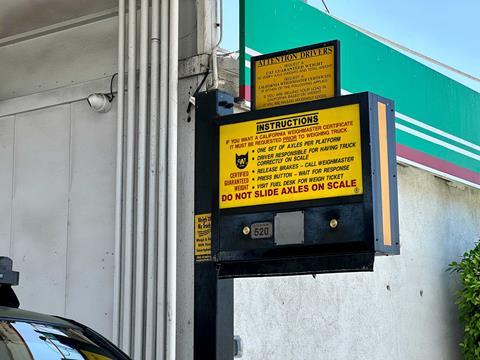
Whether you’ve just added a new set of heavy-duty wheels and tires, installed a winch, or packed your truck for a camping trip, you need accurate data to ensure you’re staying within safe limits.
So, how do you do it? We decided to take our Land Cruiser to a CAT Scale to find out.
CAT Scale: A Reliable Solution
CAT Scale is the largest truck scale network in the world, with over 2,200 locations throughout the U.S. and Canada. Typically found at truck stops, these scales are trusted by semi-truck operators who need precise weight measurements to comply with road regulations.

But they’re not just for the big rigs—CAT Scales are also an excellent resource for overlanders, off-road enthusiasts or anyone looking to get an accurate reading of their vehicle’s weight.
How to Weigh Your Vehicle at a CAT Scale
The process of weighing your vehicle at a CAT Scale is straightforward and user-friendly, even for first-timers. Here’s how it works:
Positioning Your Vehicle: CAT Scales consist of three weighing platforms. For two-axle vehicles like pickup trucks, Jeeps, and SUVs without trailers, you can position the entire vehicle on a single platform. If you’re towing a trailer, you’ll need to spread your axles over two or three platforms. CAT Scale provides a guide to help you position your vehicle correctly, ensuring an accurate reading, see the video posted below.
Using the Weigh My Truck App: To make the process even easier, CAT Scale offers the Weigh My Truck app, which allows you to weigh your vehicle directly from your smartphone. The app is intuitive and quick to use. Simply drive onto the scale, open the app, and follow the prompts to weigh your rig. Payment can be made through various methods including Mastercard, Visa, Discover, AMEX, or PayPal. The best part? You never have to leave your truck.
Recording Your Weight: Once the weigh-in is complete – which only took a split second for us, the app saves a record of your vehicle’s weight for future reference. This is incredibly useful if you’re making multiple modifications to your rig and want to track the weight changes over time. It’s also interesting to see how much your rig weighs empty versus fully-loaded with camping gear too. Our weigh-in cost us $13.50, and the peace of mind it provided was well worth it.
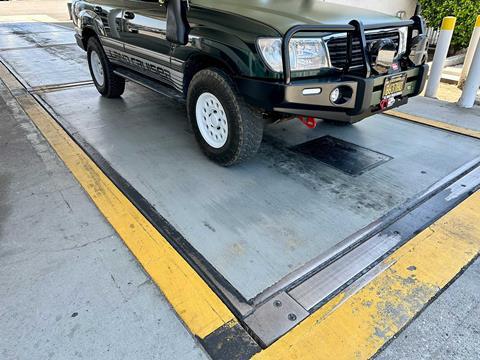
CAT Scale Weigh My Truck App Screenshots
Here are screenshots from CAT Scale’s Weigh My Truck app from our weigh session. The app is easy to use and had us on and off the scale in seconds.
Why It Matters
Weighing your vehicle isn’t just about avoiding the risks associated with overloading—it’s about being informed and prepared.
Knowing your rig’s weight at all times ensures that you can make smarter decisions about what to bring on your journey, how to pack, and what modifications are necessary.
Our Results
We weighed the Land Cruiser loaded up with some gear, the driver (yours truly), a passenger, and a full tank of fuel. What we learned during this weigh session was that this overlander is not immune to being overloaded.
Tiping the scales at 7,020 pounds, our OVR LC100 project vehicle is 160 pounds over its 6,860-pound GVWR. We’ll need to take a look at what we can do to shave some weight off of it (or maybe even ourselves!).
Increasing Your GVWR
How about increasing your vehicle’s GVWR? This is a more complex topic that we’ll tackle in a separate article, but suffice it to say, upgrading components such as suspension, brakes and tires or even shifting weight off your vehicle onto a trailer may help some if you require more weight carrying capacity.
Final Thoughts
Taking the time to weigh your off-road vehicle is an investment in your safety and the longevity of your rig. Whether you’re a weekend warrior or a seasoned overlander, understanding and managing your vehicle’s weight should be a top priority.
With tools like CAT Scale and the company’s Weigh My Truck app, weighing your rig is way faster and easier than filling up a tank of gas. Plus there’s no excuse for guesstimating your truck’s weight any longer—know its exact weight, and hit the trail with confidence.

CAT Scale Resources
CAT Scale has some videos that demonstrate how to use their scales and app.
Access More Great Stories!
For more informative articles like this, consider subscribing to OVR Magazine in print or digital versions here. You can also find the print edition of OVR at your local newsstand by using our Magazine Finder.



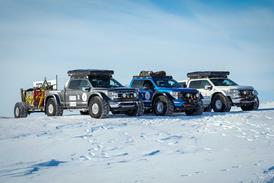

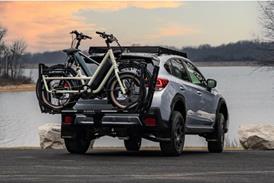
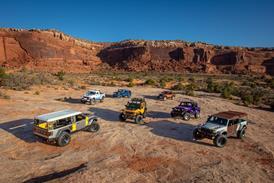


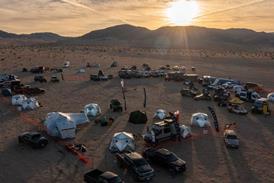
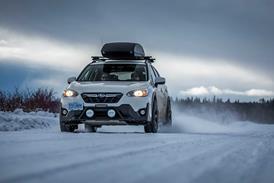
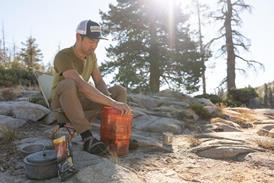


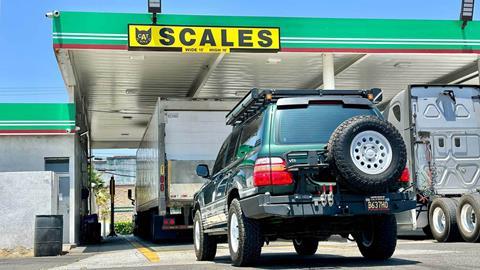



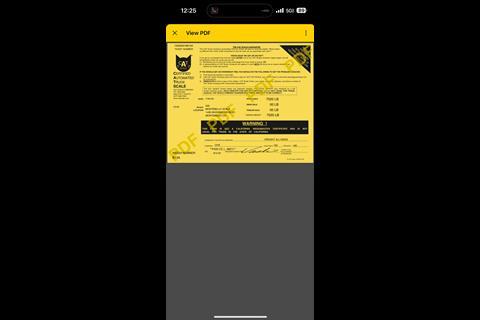






1 Reader's comment